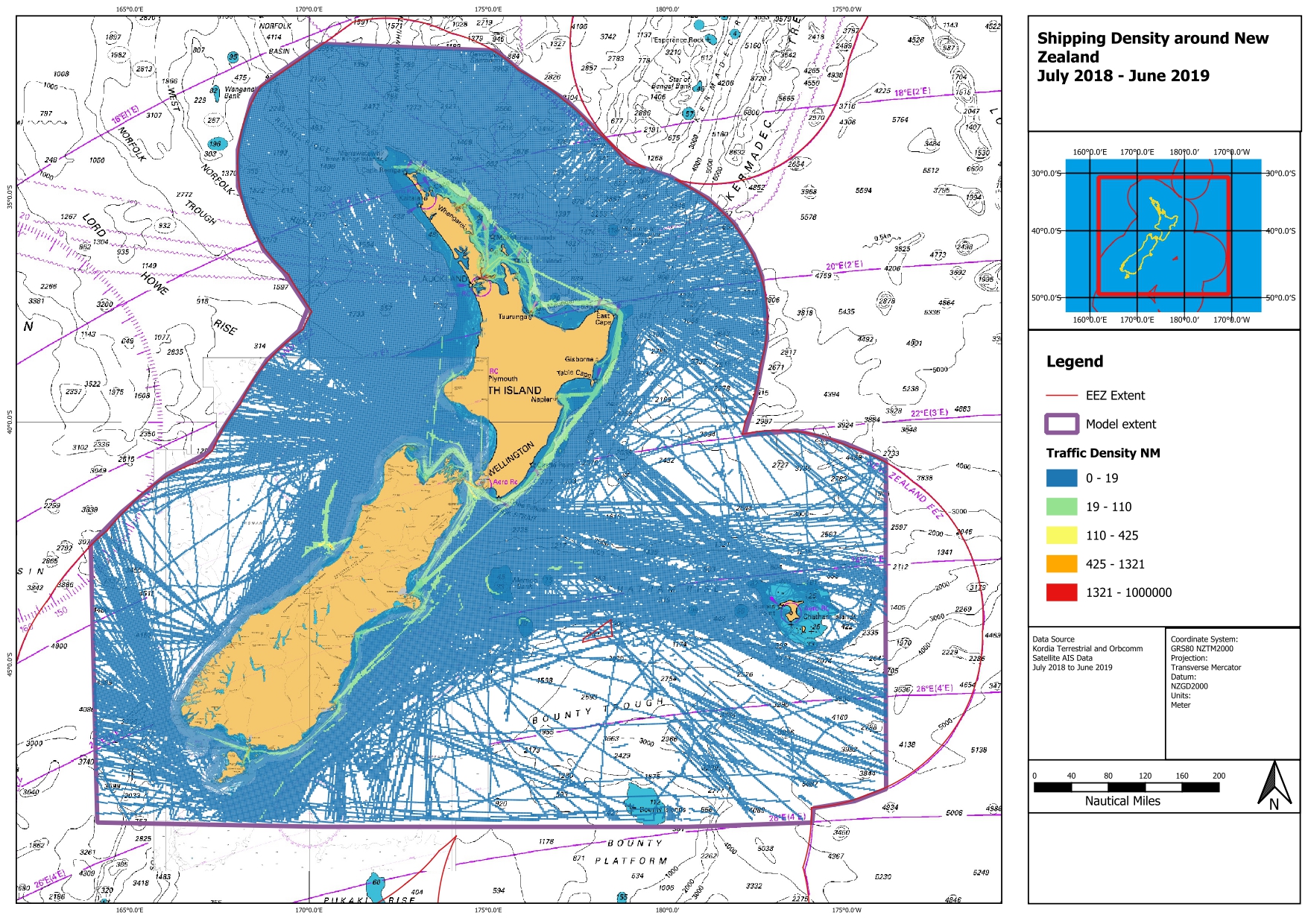Existing interests are defined under section 4 of the EEZ Act. This includes both existing activities that are authorised under an Act or Regulations (eg, commercial fishing) and those that are not (eg, shipping). The definition of existing interests also includes Treaty settlements, including through the Treaty of Waitangi (Fisheries Claims) Settlement Act 1992 (Fisheries Settlement Act), and customary marine title and protected customary rights under the Marine and Coastal Area (Takutai Moana) Act 2011 (Takutai Moana Act) and other arrangements (such as the Ngā Rohe Moana o Ngā Hapu o Ngāti Porou Act 2019).
Shipping and maritime transport
Before and during a space vehicle launch, warnings are issued to ships through Notices to Mariners and radio transmissions. These advise ships of debris hazard zones, areas where debris jettisoned during space vehicle launches is estimated to land. Ships may choose to move out of the debris hazard zone during the time debris is expected to land.
The debris hazard zones are in remote areas of the EEZ off the east coast of the North and South islands. Automatic identification system tracking of ships shows little maritime traffic in the area where debris may land. Figure 3 shows the shipping density in New Zealand’s EEZ; most traffic is concentrated in coastal areas, with low levels of traffic in the area where debris is jettisoned.
Figure 3: Shipping density around New Zealand from July 2018 to June 2019

Source: Land Information New Zealand
Of the few vessels that travel through the debris hazard zones, most are cargo or fisheries vessels.
Increased debris deposition may mean ships need to move out of debris hazard zones more frequently, increasing costs and journey times. However, given the small number of ships that travel through or into the debris hazard zones, this effect is anticipated to be low.
Commercial fisheries
Space vehicle debris is likely to be deposited in several areas designated as a fishery management area (FMA) under the Fisheries Act 1996: FMA2, FMA4, SOE (Southeast Chatham Rise), FMA3, SEC (Southeast Coast) and FMA6, SUB (Subantarctic).
An increase in launch debris deposition requiring debris hazard zones may affect the ability to exercise commercial fishing rights. Fishing ships may decide to move out of the debris hazard area or avoid it entirely, affecting their ability to catch fish. However, the automatic identification system tracking of ships in the debris hazard zones shows few vessels travelling into or through the debris hazard zones. This suggests not much fishing activity that could be displaced, meaning any effect of increased launches is anticipated to be low.
Māori interests
Māori have a cultural, economic and spiritual relationship with the marine environment. This relationship is grounded in whakapapa (ancestry) and expressed through tikanga (custom) and kaitiakitanga (guardianship).
The EEZ contains spiritual pathways in te ao Māori, such as the area between Te Rerenga Wairua (at the top of the North Island) and Manawatāwhi (Three Kings Islands). This area is excluded from the current authorised launch deposit area. Māori consider the health of the ocean to be intrinsically linked to the wellbeing of people. They exercise kaitiakitanga over marine taonga (cultural treasures) within their rohe moana (customary fishing areas), which may extend into the EEZ. This includes responsibilities to protect and restore the mauri (life force) of the marine environment, and to maintain intergenerational knowledge and cultural practices associated with the sea.
Māori have fisheries interests in the EEZ through the Fisheries Settlement Act, including commercial quota holdings, customary fishing rights, and ownership stakes in fisheries companies. Māori also hold rights under the Takutai Moana Act, although this applies only to the territorial sea. Increased space vehicle jettison debris could impact the exercise of commercial fishing quota allocated under the Fisheries Settlement Act (see the Commercial fisheries section for more detail).
Rocket debris from space launches poses a low risk to marine species up to 1,000 launches (see the Environmental effects section for more detail).
Customary fishing takes place within rohe moana (defined customary fishing areas) of tangata whenua. Limited information exists about how increased launch debris deposition within affected rohe moana would affect how Māori interact with, harvest or manage customary resources. Effects may be similar to those for commercial fisheries and shipping. Based on the low level of activity in the debris hazard zones, the effect of increased launches is anticipated to be low.
Treaty settlements and other arrangements are considered existing interests under the EEZ Act. For the debris hazard areas, these include:
- Moriori Claims Settlement Act 2021
- Ngā Rohe o Ngā Hapū o Ngāti Porou Act 2019
- Ngāi Tahu Claims Settlement Act 1998
- Treaty of Waitangi (Fisheries Claims) Settlement Act 1992 and Māori Fisheries Act 2004.
Oil, petroleum and resource extraction
No petroleum permits have been issued for the authorised launch deposit area.
One mineral mining permit is active in the authorised launch deposit area, on the Chatham Rise. This permit grants exclusive rights to mine phosphorite nodules, but no mining activity is currently taking place in the area. A marine consent is required for any future mining activity.
An increase in space vehicle jettison debris would not have any effects on oil, petroleum and resource extraction. Any operators considering applying for exploration or mining permits in the authorised launch deposit area may need to consider the potential for space vehicle jettison debris to be deposited in the area they are interested in.
